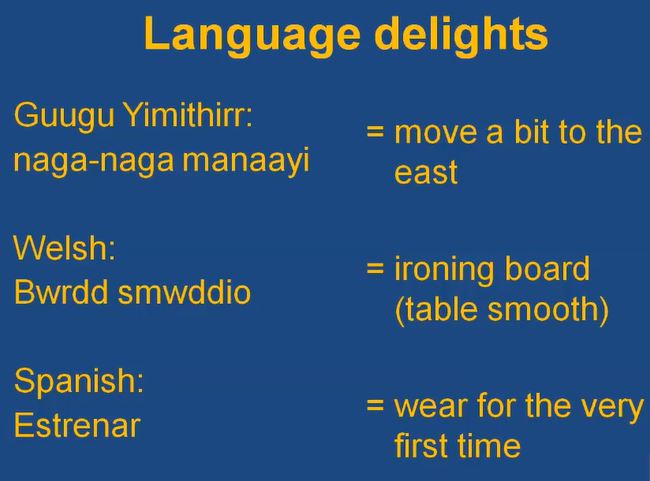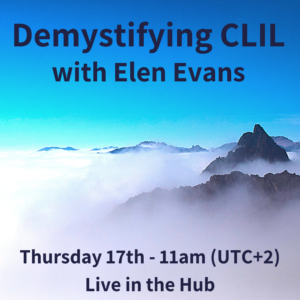For this webinar, we were joined by the wonderful Elen Evans of STEM Ginger Education. Elen started working in ELT in 1999 and then decided to train as a natural scientist. Nowadays, as well as teaching General English, she combines her knowledge of natural science with teaching. She’s taught a variety of courses, from recycling to adults with an A1-A2 level in Catalunya to virology with high-level students in Italy. Although we often associate CLIL with mainstream education, Elen shows that these courses can also be a stand-alone part of language learning.
What is CLIL?
Elen started out by saying that it’s not a particularly catchy acronym and perhaps suggested ‘subject teaching through English’ as an alternative (though apparently David Marsh, a leading expert on CLIL, believes they are different things). There was also an interesting comment in the chat that teaching subjects through English doesn’t necessarily mean teaching English through subjects.
We had a quick chat about words we associate with CLIL:
- knowledge
- expertise
- broader learning
- learning a language and subject together
- other curriculum subjects taught through English
- interactive and communicative
- creative
- project-based
- inclusive and varied
- promotes critical thinking
- motivational
While we teach, we learn
We chatted as well about how it can involve a little extra preparation at the start to help us feel comfortable with the content. However, it enables us to enrich our skills and interests and share our passions with others. It also allows us as teachers to do something a little different, rather than just revisiting the present perfect for the umpteenth time.
Are there any subjects which aren’t suitable?
We imagine that no – any subject which can be taught in one language, can be taught in another. There is obviously the question of the frequency of the language that you’re using, which is also true when you learn the topic in your own language too. There could be some cultural aspect to it – for example, it might be strange to learn Spanish history or Italian geography in English. However, we also noted that some subjects – such as history or religion – may be viewed in a different way from a different culture or country’s context. As a positive, Elen suggests that CLIL can open up borders and give learners a wider view of the world.
Elen also highlighted that although English is often seen as a global language, she’s concerned about it being seen as more important than other languages and languages losing their cultural significance. She suggests that CLIL may be able to provide more balance as the two languages taught are equally weighted.
There was also a question of whether learners are disadvantaged and will struggle to learn adequately in the two languages. Interestingly, that afternoon, a post popped up on my Twitter feed about a school in Valladolid which was abolishing the bilingual system because of some of the concerns around first and second language acquistion (the tweet and report are in Spanish).
However, it’s always true that in any subject there are learners who are more interested in the subject and even a topic: those who are motivated to learn the lexis in their own language will go away and look it up for themselves. Elen also highlights the importance of cross-curricular work so the subject teacher can focus more on the content whilst working alongside the language teacher to provide linguistic support.
Linguistic value and heritage
We took a quick peek at the richness of language – how in some languages they use compass points rather than left and right; how languages adopt newer terms from other languages, such as ‘table smooth’ for ironing board in Welsh; or how in some languages one word replaces a string of words in another.
Elen mentioned a podcast from The Guardian about whether we will lose our knowledge of plants as indigenous languages die out – again, she hopes that with an integrated approach where the first language is as valued as the second langauge, this won’t happen.

We went on to look at some key terminology including hard and soft CLIL, BICS and CALP and LOTS and HOTS. You can learn more about them from Elen’s slides and she’s also shared some other sections of her presentation here. Later on, Elen talked about the different language which we’ll introduce learners to as part of a lesson:
- content-obligatory / subject-specific vocabulary would be the words which would probably be lower frequency in an ELT context
- content-compatible / general vocabulary would be key words which we use outside the subject in general English
- high-medium frequency words, which is lexis learners would be familiar with through their general English (prepositions, quantifiers, and so on)
- collocations which are specific to the subject but important for the linguistic support
Also in terms of supporting learners, Elen highlighted the importance of providing examples, spending time to look at structures and meaning but also encouraging learners to notice language, and correcting. She also noted that CLIL can be quite laborious in terms of identifying the structures which will be important to teach the subject content. As a way to support each other in this aspect, Elen has set up a FABULOUS folder where we can add and share lesson plans. It’s well worth a look, even if you’re not teaching CLIL per se, as there are lots of great lesson plans in there already.
Other factors which might put people off are the lack of knowledge of the subject. When I was involved in a CLIL project as part of mainstream education, I found it incredibly challenging to gauge what aspects of the subject I needed to include in a course for a group of 10-11 year-olds: was I asking too much of them? It felt at times that the language was too challenging (and would probably be graded at a much higher level due to being low-frequency) but that was the vocabulary that they would have been learning in their L1.
I asked Elen about pitching the level of language and she mentioned that another benefit of CLIL is that it allows for differentiation and can be motivating in different ways – a learner who struggles with the L2 may have good subject knowledge whilst another might be very good at the L2 but find the content more difficult to manage.
Elen’s projects have already brought together learners from Mali, Tanzania, Argentina, Colombia, Spain, Italy, Portugal and the UK.
She’s written a number of articles about CLIL:
CLIL: The good, the bad and the not so ugly on SLB Coop
And three article on Freeed:
There’s been some interesting follow-up chat following Elen’s session regarding the approach that some countries have taken to implementing bilingual education, so have a read of the thread on Facebook.
HUGE thanks to Elen for joining us and sharing her expertise and passion for this area of education!
Questions to reflect on:
- If you are an ELT teacher, what topic areas would you particularly enjoy teaching in mainstream education?
- What do you feel are the benefits and drawbacks of CLIL?
- In some areas, a bilingual education system is considered to put lower-income students at a disadvantage. What do you think needs to be done to ensure equity in education in this case?


We chatted about some concerns from both teachers and parents about the effectiveness of bilingual programmes. This article from a Spanish newspaper which has been translated into English talks about some of the issues and why many Spanish schools want to opt out of the system: https://english.elpais.com/society/2021-07-05/the-spanish-schools-dropping-out-of-bilingual-education-programs-its-a-sham.html
Just adding this here so I don’t lose it! Really interesting blogpost about Pete’s recent experience with CLIL: https://eltplanning.com/2021/11/03/eal-science-and-cliling-it/